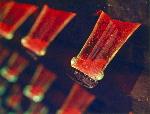 The process of making Champagne is an hands on method. From picking to Riddling. Methode Champenoise is the term use to make Champagne. Today we have two methods, Methode Classique or Methode Traditional.
The process of making Champagne is an hands on method. From picking to Riddling. Methode Champenoise is the term use to make Champagne. Today we have two methods, Methode Classique or Methode Traditional.First, fermentation occurs after the grapes are pressed and stored in stainless steel tanks. Some Champagne does go through the first fermentation in oak barrels. It is at this step where the yeats is added. The conversion of the sugars into ethanol and carbon dioxide produces the first fermentation. This process produces a still wine.
After the first fermentation, the winemaker or"chef de caves, cellar master as they are called in France" will blend the grapes. The blending of the grapes is different within each of the villages of Champagne and is different from vintage to vintage.
Once the blending is complete the wine is placed in the bottle in which the Champagne will be sold. A mixture of sugar, yeast and old wine is added in order to induce the mousse or bubbles. The bottle is then closed with a crown cap and laid down horizontally in a cool dark cellar. This second fermentation takes place over the course of three months. Carbon dioxide and fermentation lees form within the bottle. This long fermentation process is responsible for the formation of the tiny bubble characteristic of Champagne.
After the second fermentation the Champagne is aged. Champagne can be aged for up to three years and the finer Champagne can be aged more than six years. As the Champagne is aged, the wine does go through some changes due to the contact of the lees with the wine. This leads to some unique characters you may taste, flavors of nuttiness or toastiness.
 Next step is the riddling. This step takes place after the aging is complete. The winemaker removes the dead yeast cells out of the bottle without losing the carbonation. Bottles are then placed in special racks that keep their necks tilted downward, forcing the dead yeast cells into the neck of the bottle. Twice a day the bottles are lightly lifted, turned a quarter of a turn and then put back down in the rack. This procedure is repeated every second or third day. This process averages eight weeks by hand.
Next step is the riddling. This step takes place after the aging is complete. The winemaker removes the dead yeast cells out of the bottle without losing the carbonation. Bottles are then placed in special racks that keep their necks tilted downward, forcing the dead yeast cells into the neck of the bottle. Twice a day the bottles are lightly lifted, turned a quarter of a turn and then put back down in the rack. This procedure is repeated every second or third day. This process averages eight weeks by hand.The final stage of making Champagne is called Disgorgement and Dosage. In disgorgement, the necks of the bottles are frozen creating a small ice plug at the top of the bottle that traps the sediment of the dead yeast cells. when the caps are removed, the pressure released shoots the ice and all the yeast sediment out of the bottle. Some wine is lost by this process but is replaced through a process known as dosage. It consist of adding a small amount of sugar dissolved in wine before the cork is inserted into the bottle. This mix which is referred to as liqueur d'expedition, defines the sweetness of the dosage.

Next post - the Issue at Hand

3 comments:
Are there any good sparkling wines from the Hudson Valley?
I prefer to drink champagne in a speciall time like when i go out with my boyfriend or when i have an important meeting with my partners. I think this drink is very delicous!!!!
This is the reason why i was interesting to read this wonderful blog. Actually my boyfriend is decided to buy viagra and we going to drink a good champagne this night of course.
I had a meeting days ago with my partners in costa rica investment opportunities and we drank a great champagne, the taste was really delicious and the dinner, oh my god delicous too.
Post a Comment